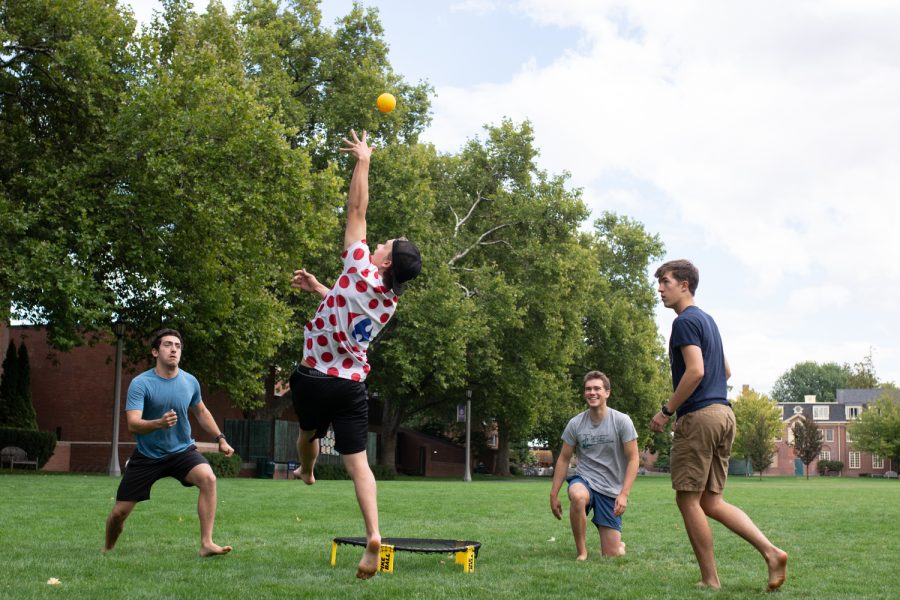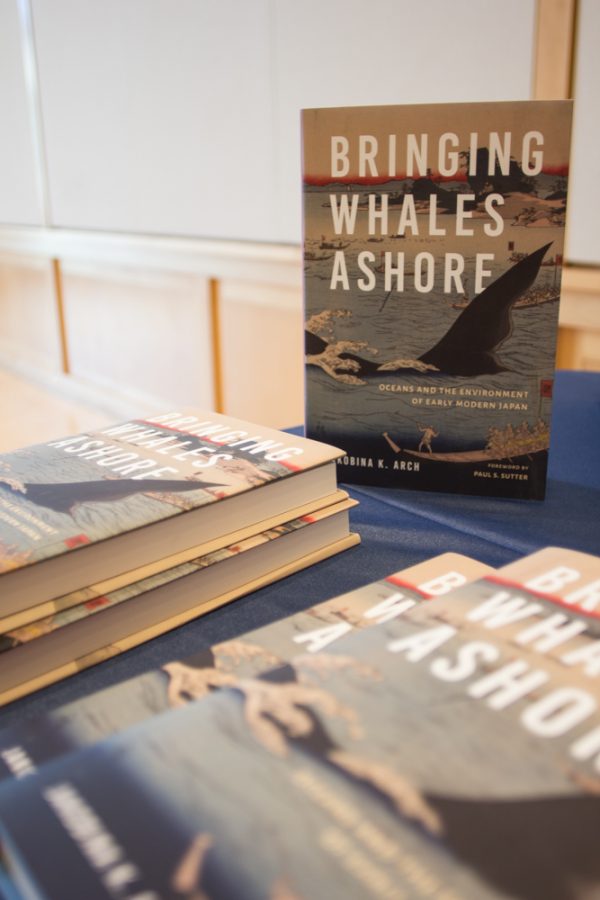I haven’t posted for a couple of weeks. My bad. It hasn’t been for a lack of content: there are always tons of stories to tell: but rather a lack of time. Last week was especially stressful, and I’ll try to get to that in another post. For now, though, with the little free time I have, I thought I’d share a bit of what I’ve done since my last post.
I climbed a mountain.
One of the first Japanese friends I made, Tarou, likes to go hiking in his free time, and he invited us to come along with him when we had a free day. I hadn’t gone hiking in a while, but my host mom made me a bento, I loaded up my backpack with water bottles, and off we went. We climbed Hieizan, or Mount Hiei. Hieizan straddles Kyoto and Shigo prefectures, and from the top, you can see not only the two prefectures, but Lake Biwa off in the distance as well.
The hike was great, if a little tiring. It was a hot day in the city: about 28 ° C: but the mountain, being shaded and of higher elevation, was pleasantly cool (and even got chilly as we got higher up). We saw a scattering of various types of wildlife, including the still-startlingly-large spiders that are everywhere in Japan, snakes, and bees the size of your little finger, from the middle knuckle to the tip. I wasn’t quite a fan of the last one. At the top, though, it was all completely worth it, because not only did we get a beautiful view of the surroundings, but we also got to explore Enryaku-ji (Enryaku Temple), a Buddhist temple and monastery.
It was overall a brilliantly successful day. It’s especially fun to hang out with Japanese friends: all of my Japanese friends thus far are kind and friendly people, and I really enjoy getting the opportunity to get to know them. Plus, I climbed a freaking mountain. That’s pretty cool.
I ate at a sushi restaurant.
My host mom had a meeting of some sorts, so rather than cooking, my host dad and I decided to eat out. After a little bit of driving around Uji, we found a sushi place.
Now, this may not seem groundbreaking to you, but it was an entirely new experience to me. Particularly so because the restaurant we went to was nothing like any other sushi place I’ve been to before. For starters, even though it was lit with fluorescent lights and seemed for all intents and purposes like a fast food restaurant, its sushi was nevertheless delicious, and tastier than almost all of the sushi I’ve had in Portland.
The sushi rotated around the restaurant on a conveyer belt, much like anyone who’s been to a sushi bar in America would expect. But instead of just going in one loop, the conveyer belt actually spiked out and back along long rows of booths. In each booth, there was a box containing 抹茶 (maccha –– powdered green tea), a hot water spigot, and a touch screen for custom-ordering sushi, as well as (of course) the conveyor belt.
Like I said, the sushi was delicious. I’m particularly partial to salmon sushi, but I had tuna, I had egg, I had squid: I had all sorts. It was never anything too complex, either: a really complex piece would have rice, a spot of wasabi, the fish, and some green onions, drizzled with mayonnaise. But the fish was so tender and smooth, and the rice so perfectly sticky that the food at this brightly-lit fast food sushi bar quickly earned a very high spot on my list of sushi places.
I visited Kiyomizu-dera.
One of the things on my list is to join a circle. Circles are student-run extracurricular activities at school, like clubs, except that “club” has a different, more strict or formal meaning, as far as I can tell. (Think the distinction between varsity and IM sports.) The circle I want to join is English Work Shop, or EWS, which is a language exchange circle. We meet once a week, and the English speakers help Japanese students learn English, then, after dinner, we switch roles and the Japanese students help us learn Japanese.
Meetings haven’t officially started yet, but we’ve done a few unofficial things as friends, and one of them was to visit æ¸â€¦Ã¦°´Ã¥¯º (Kiyomizu-dera), one of the most famous temples in Kyoto. It’s known for its spectacular view of the city, as well as its tall veranda stretching out over the forest. We went, a group of about half American students and half Japanese, and spent the day wandering the temple grounds and then exploring the city a little bit.
When we had just stepped onto the grounds and were milling about, we were approached by a group of Japanese students, very well dressed and slightly shy, about middle-school age. They asked us if we were from America, and when we said we were, they read to us the list of questions they had prepared as homework for their English class. This wasn’t the first time this had happened to Sam or me; when we visited Toji a few weeks ago, we also had the opportunity to help some Japanese students with their English (although Sam and I also ended up speaking basic Japanese at them, so it was not a 100% perfect realization of the assignment). We figured then that it made sense to look for Ã¥¤-人 (gaijin) at Toji, since it was a famous site and thus a draw to travelers. At Kiyomizu, the students asked their questions, we responded cheerfully and complimented them on their English, and then we took a picture together. They left… and then before we knew it, another group of students had found us. We must have really stuck out.
Exploring Kiyomizu was wonderful, although, as usual, I think I would have liked to have far more time to do it. The last time I was in Kyoto, four years ago, I also visited the temple, so parts of the visit sparked seeds of nostalgia as we wandered around. We weren’t the only foreigners, either: I saw a bunch of American high school students, probably doing something similar to my People to People trip, and was quite amused.
It’s a really interesting thing, this cultural adaptation. I’ve only been here a month, but Kyoto is starting to feel like home, at least for right now. I take the train, I can get around the city (at least somewhat), I’ve bought groceries and eaten at restaurants and asked for directions. All of these little things, day-to-day behaviors that I never think about, have been accumulating a bit at a time, and each time I successfully complete: or at least don’t fail: another of them, I inch a little closer to feeling comfortable, competent, and at home. Part of that entails noticing tourists. When I ran into the American high school students, for instance, my first thought was something like, “Oh, look at the American tourists being loud and obnoxious.” I’m starting to adopt a view of Americans (or, to be more accurate, Caucasians) as outsiders…even though I myself will always look like just as much of an outsider.
Anyway, the point is that I really wanted to photobomb some of the Ã¥¤-人 (gaijin) when they were taking their pictures, because I figured it would take a few viewings before they realized that the other white guy in the background actually wasn’t anyone they knew. But I didn’t.
A couple of the last interesting observations at Kiyomizu came when we wandered up some stairs to an area near a Shinto shrine. First, the relative ease with which the two beliefs share space is quite interesting to me: while I’m sure they exist, the idea of a hybrid church/synagogue/mosque sharing ground in America seems like a recipe for a tense internal relationship. In Japan, it just ain’t no thang. I’m sure there’s a lot more to what’s going on with it, especially since most Japanese, according to what I’ve read, are relatively atheistic and don’t believe too much in either Shinto or Buddhism; and also given the fact that Shinto and Buddhism, again according to stuff I’ve read, can be fairly harmonious. Still, it strikes me as a bit unusual, from my American standpoint.
The other unusual sight, at least to my American eyes, is how much there is for sale at temples and shrines. You can buy good luck charms or prayer placards, a sheet of paper to write your troubles on and subsequently dissolve in water, or any number of other goods. Now, I’m sure it helps keep the temples and shrines afloat, especially when they attract so many tourists, so I can’t really blame them, but it sure caught me by surprise the first time I encountered it. In predominantly Christian America, that idea seems a little foreign; after all, Jesus cast the money-lenders out of the temple. To me, this suggests a difference in attitudes toward commerce and seeking profit, but I don’t want to baselessly speculate too much. Suffice to say that I was caught unaware, and it took a little willpower not to buy anything…until I realized that everything was extraordinarily marked up, like the paper dolls you could write your troubles on and dissolve in a bucket, which cost 200 yen a doll. Maybe the invisible hand is universal after all.
I went to a Hanshin Tigers baseball game.
If there’s anything I’m not, it’s a sports fan. I don’t watch sports on TV, I don’t go to my school’s sports events, and I certainly don’t play any sports. I mean, yeah, I understand most sports, but I’m the guy who can make those jokes like shouting “Touchdown!” when a basketball player makes a shot. They’re not particularly funny jokes, but I’m so not sports-y that someone could imagine me getting the terms for different games mixed up. Oh, Spencer, you adorably dumb little scamp.
For “Lenses of Culture,” my psychology class, though, we had a field trip this last week to go see a baseball game in Osaka: the Hanshin Tigers versus the Tokyo Yakult Swallows. And hey, I’m not one to pass up on free mandatory events, so I thought I’d come along. The getting there and back was stressful and not fun for a number of reasons, which I may elaborate on shortly, but the game itself was a blast. Even if I didn’t know all the chants and songs the fans were singing, it was fun to wear the complimentary Tigers cap, clap along, and feel the surge of excitement when a Tigers player would make a particularly satisfying hit.
One thing I had been told about prior, but had entirely forgotten until it happened, was the fans’ custom at the 7th inning. As the 7th approached, we started seeing people with long, skinny balloons. Nobody had blown them up yet, but they were everywhere. When the 7th inning began, all of a sudden, people blew them up. The stands were a sea of large latex balloons, their owners seemingly waiting for some cue. And then, on some signal that I missed, everyone let go at the same time! Their balloons rocketed out into the air, whining and sputtering as the air escaped. It was silly and unexpected: and a lot of fun.
In the end, the Tigers, despite their reputation as an underdog team, won the game with a score of 9-3. Guess their star quarterback was really making the slam dunks that night.
I barely struggled through last week.
It hasn’t all been balloons and sushi, though. Last week was hellish in terms of workload.
One thing that I’ve been noticing is that I simply have less time here than I do at Whitman. This is partially due to the extracurriculars I’m participating in, EWS and taiko; partially due to the heavy, heavy workload for my Japanese class; and partially due to the sheer fact that about an hour and a half of each day is spent on the train. Even during a normal week, there’s just not a lot of free time, which means I have to squeeze my homework in whenever I can. This has meant studying kanji on the train, doing homework in the AKP lounge between classes, and simply sleeping less. It’s not ideal, for someone who likes his relaxation and his free time, but that’s the way it goes.
But last week was even worse than the norm. Last week, I had two tests, a lesson test in Japanese on Monday, and a midterm in psych on Wednesday. Tuesday night, we went to the baseball game in Osaka, which took a good five or six hours out of the evening. Tuesday morning, I had a small presentation in Japanese, and on Thursday, I had a larger presentation of a research project: one that I didn’t get the chance to research until Tuesday or Wednesday. All of this in addition to regularly-scheduled homework. There aren’t enough syllables in the word “overwhelming” to express how overwhelming it was.
Talking with other AKP friends, it seems like I wasn’t the only one. I think we’re starting to see the beginning of a downward mood shift in general. Like I’ve mentioned, the “honeymoon” phase of the cultural transition is over, and we’re starting to settle in. I think right now, many people: myself included: are feeling trapped and frustrated by their inability to understand and be understood here. We’re all learning, for sure, but now that Kyoto is starting to feel like home, we can’t learn fast enough.
Add to that mixture the fact that in AKP, the inevitable social circles have been drawn. While I don’t think anyone’s really antagonistic or exclusive, social cliques have nevertheless been formed among people who often hang out with each other, and some people seem to have been left outside of all of the circles. As someone who’s in one of those circles, I’m not particularly proud of this, so I’ve been trying to actively reach out to the people who seem like outsiders, but nevertheless, I think many people are feeling a bit of social frustration now that there are informal social groups.
The fact that there’s also AKP drama probably plays into that a little, but I’m so disconnected from that. People are dramatic and I can’t help but feel that it’s a little immature, but it’s rather contained to the social bubbles I’m not part of, so I haven’t had much real experience with it. I don’t know if that’s because my friends just haven’t had anything to get dramatic about, or if I just make friends with people who don’t generate drama Either way, it’s the sort of thing that I hear of and think is very silly, but don’t see much of myself.
At any rate, I made it through, but only barely. Through a combination of strategically-placed naps, working like a madman, writing an email to my Japanese professor, and Boss Rainbow Mountain Blend coffee, I was able to persevere, and when Friday (the 7th) rolled around, I was more than ready to go off on an AKP field trip and relax in 温æ³â€° (onsen –– hot springs). But that’s another story for another time…
More of my stories from abroad, as well as photos and other goodies, can be found at my travel blog, Experiencing the Seasons.




